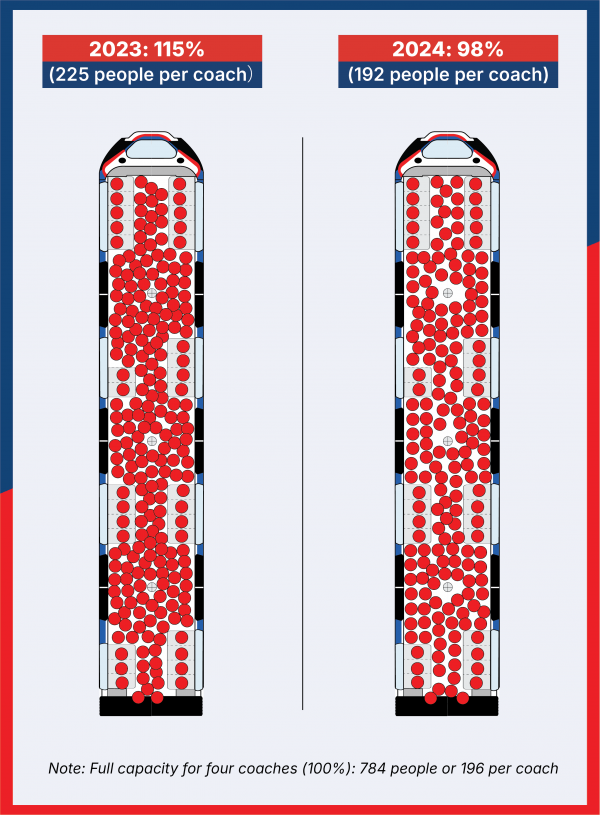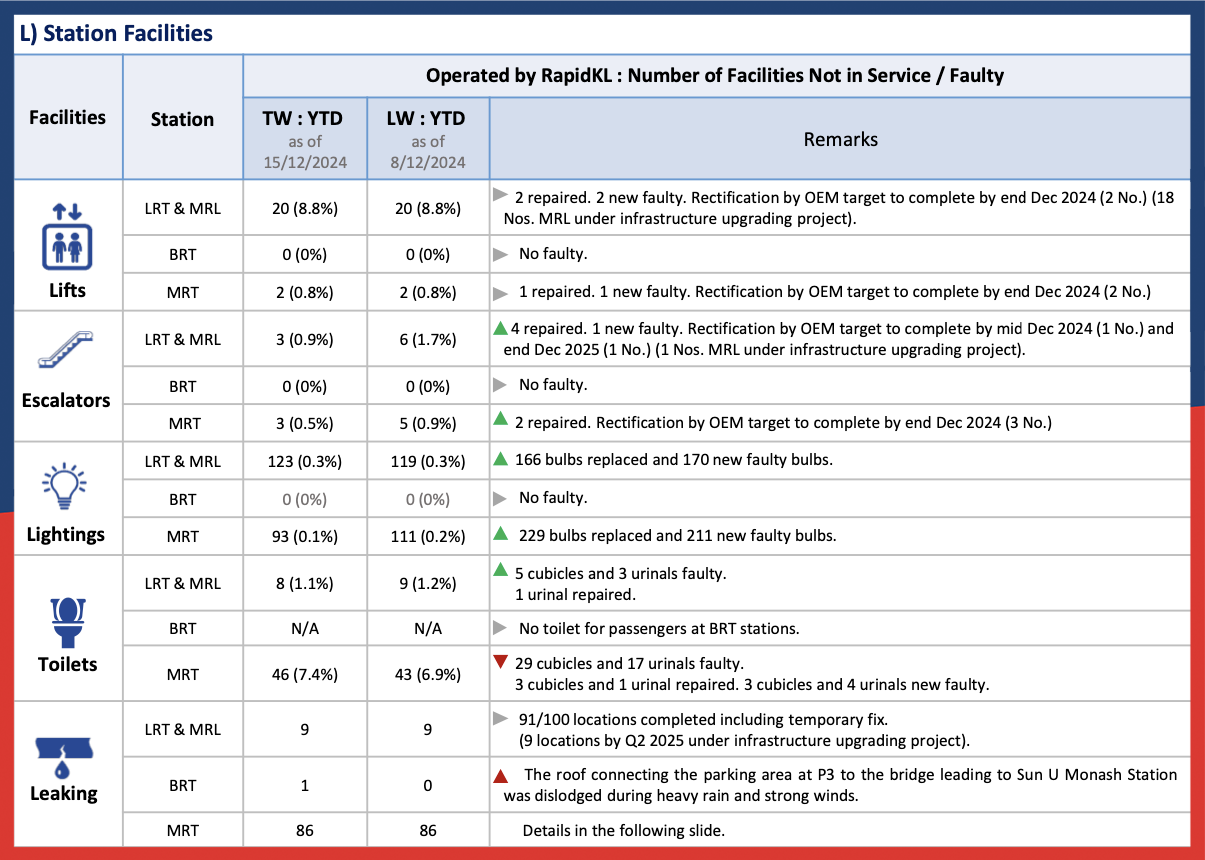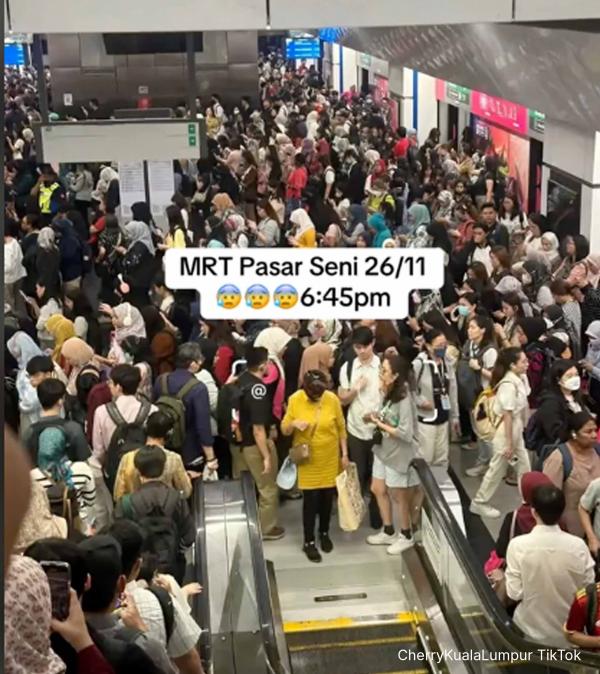Jan 15, 2025
It took a concerted effort to turn things around. Here’s what made the difference.
If you rely on the two busiest rail lines in the Klang Valley - Kelana Jaya LRT and Kajang MRT - to go about your day, you may have the impression that the lines frequently break down.
You’re not far off the mark.
Kelana Jaya line
In 2023, the Kelana Jaya LRT line broke down up to five times a month.
In total, there were 36 breakdowns in 2023.
In 2024, the Transport Ministry aimed to reduce the number of breakdowns, setting a target of no more than 28 times that year.
By the end of the year, the Kelana Jaya line broke down 26 times, within the target and a 28 percent reduction from before.
As for the Kajang MRT line, there were 38 disruptions in 2023, and the target for 2024 was no more than 21 times.
In 2024, disruptions to the line were reduced to 20 times, an improvement of 47 percent.
The improvements are thanks to Rapid Rail engineers and operations team, who have been working hard to bring these numbers down.
Peak-hour waiting times have also been reduced, resulting in less crowded trains.
Train waiting times
2023 | 2024 | |
|---|---|---|
Kelana Jaya line | 4.1 minutes | 2.9 minutes |
Kajang line | 6 minutes | 4 minutes |
How does cutting peak-hour waiting time by merely one minute help significantly reduce crowdedness? This animated infographic explains:
In 2023, Kelana Jaya line trains were operating at 115 percent capacity. This means passengers were packed as tight as sardines!
Last year, the crowdedness went down to 98 percent.

The gamechanger
What’s behind the turnaround of the Kelana Jaya LRT and Kajang MRT lines?
A major game-changer, the Prasarana team said, was the decision to benchmark themselves against the internationally-adopted industry measure called the Mean Kilometre Between Failure (MKBF).
MKBF
Normal Operations
Distance until failure
→
MKBF measures the average distance covered before a breakdown happens.
Imagine, today the line runs this far before a breakdown.
Then it continues to run for some distance.
After another breakdown, it runs again.
The average distance it covers before a breakdown gives us the MKBF. The higher the MKBF, the better!
Based on this measure, the Kelana Jaya LRT line’s MKBF has improved by 53 percent since January 2023 while the Kajang MRT line’s MKBF increased by 51 percent.
“MKBF is a critical performance indicator for enhancing train reliability and operational efficiency. For Prasarana, achieving a high MKBF translates to fewer service disruptions and increased passenger satisfaction,” said Rapid Rail in a statement to Malaysiakini.
The Transport Ministry’s vision is for Rapid Rail to eventually achieve one million kilometre MKBF, which translates to no more than four disruptions in a year.
Obsession with failure lays tracks to success
Leman Zakaria is the head of engineering for the Kelana Jaya LRT line. His job is to keep the trains running and he does this by being obsessed with failure.
Since 2023, there has been a special team whose main task is to analyse the failures experienced by the Kelana Jaya line every day, using specialised engineering software.
The daily microanalysis helps the maintenance team get ahead of potential problems.
For example, he said, when a failure repeats itself, it is immediately flagged and the team can quickly investigate and recommend maintenance action.
This may include changing a specific component of the train, even though its lifespan may be longer according to the manufacturer’s manual.
Rapid Rail’s control centre not only receives real-time feedback from the driverless trains on their conditions, speed, and locations. The control centre also monitors crowdedness at platforms.
The data is used to anticipate if empty trains need to be sent to ease congestion and whether to deploy officers to manage the crowds during peak hours, said the Kelana Jaya line’s head of operations Noordin Abu Bakar.
This usually happens at interchange stations like Pasar Seni during peak hours, he said, so empty trains are sent there at these hours.
Noordin said the growth in ridership, especially with the expansion of rail lines to more areas in the Klang Valley, added pressure to the Kelana Jaya line.
“The challenge we are now facing is the demand from customers. When we have three minutes of headway (train frequency), they are demanding more than that. That is the main challenge.
“And with the expansion of rail lines in the Klang Valley and development along the rail lines, the increasing number of passengers is a big challenge for us in terms of crowd management,” he said.
Meeting the boss every week
One key factor in keeping the team on its toes is the weekly briefings with the boss - Transport Minister Anthony Loke, which started in January 2023.
Held immediately after post-cabinet meetings, Prasarana and Group Chief Executive Officer Mohd Azharuddin Mat Sah gives a briefing on key measures - like ridership, how crowded the trains were, how many breakdowns occurred and why, and the sales of MY50 passes.
The briefing is so detailed that the CEO even has to report how many light bulbs are faulty, what has been done to patch up leaking roofs, whether toilets are running and if lifts, escalators, and other station facilities are operational.

He also addresses public criticism of mass transit, including social media posts that have gone viral.

When Malaysiakini was given access to one such meeting last year, some photos of crowdedness at the Pasar Seni station had gone viral.
This was how it was addressed.
Azharuddin said the weekly meetings were pivotal in helping drive performance at Prasarana, evidenced by the documented improvements in its two busiest rail lines - Kelana Jaya and Kajang.
The weekly briefings force the operations team to address issues immediately, because updates need to be provided the very next week, and resources can be allocated more urgently, he said.
Since June 2023, Prasarana has also begun publishing the key performance metrics on its website for public accountability.
Also if we need any help or support from either the ministry or the minister we’ll be able to get it immediately.

Do commuters agree that things are getting better?
A flaw in the design
However, the Kelana Jaya and Kajang lines are only a small part of the Klang Valley public transport infrastructure, stressed Transit Malaysia, an NGO advocating for better public transport in the country.
In fact, unlike cities with similar urban sprawl, fewer people in Greater Kuala Lumpur ride the bus compared to trains, said the NGO’s co-founder Muhammad Zulkarnain Hamzah.
Without an effective bus service and pedestrian-friendly access, the Klang Valley rail network will continue to be plagued with first and last-mile challenges, where passengers have problems getting to and from the rail station, he said.
There is also growing car dependency, with more and more highways cutting pedestrian access which compounds poor pedestrian and cycling infrastructure, said urban planning advocacy group Urbanist KL.
Besides reducing the number of highways, the group said car dependency could be cut by introducing congestion charges and higher parking fees to discourage driving into the city, with proceeds going to improving public transportation.
More buses needed, some on the way
Urbanist KL said a sprawling city like the Greater Klang Valley should have many more buses than the about 1,000 in daily service.
Transport Minister Loke acknowledges that the city needs at least 4,000 buses and the government procurement process is already underway to secure some of that.
Prasarana is currently procuring 310 diesel buses, 250 electric buses, and 300 vans.
Dedicated bus lanes at busy routes like on Jalan Ampang in downtown Kuala Lumpur have also attracted higher ridership, with Rapid Bus boasting a peak-hour frequency of every five minutes on that route, Acting Rapid Bus CEO Ku Jamil Zakaria said.
The same frequency can be experienced for the high-demand Jalan Klang Lama and Genting Klang routes.
He said an ongoing demand study is hoped to provide the data needed to replicate this in different parts of the city.
Rapid Bus’ success is pivotal to ensuring the city’s major investments into rapid rail services will pay off.
“Any urban rail service can’t reach its full potential when the complementing service is ineffective,” Transit’s Zulkarnain said.